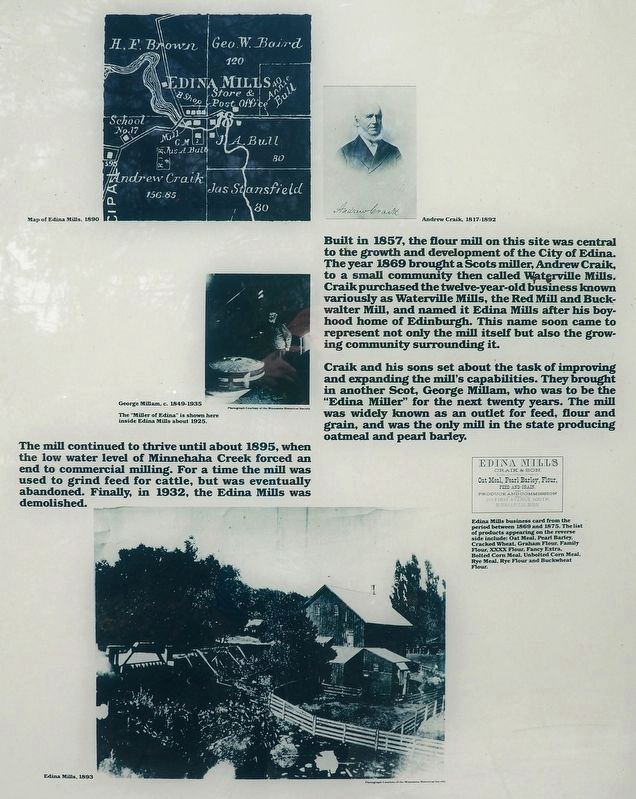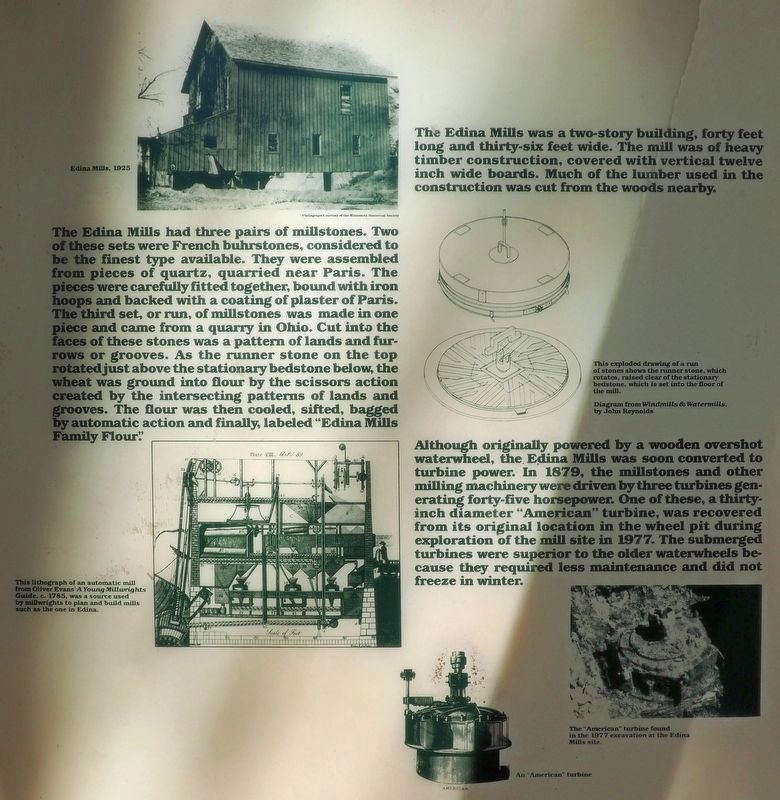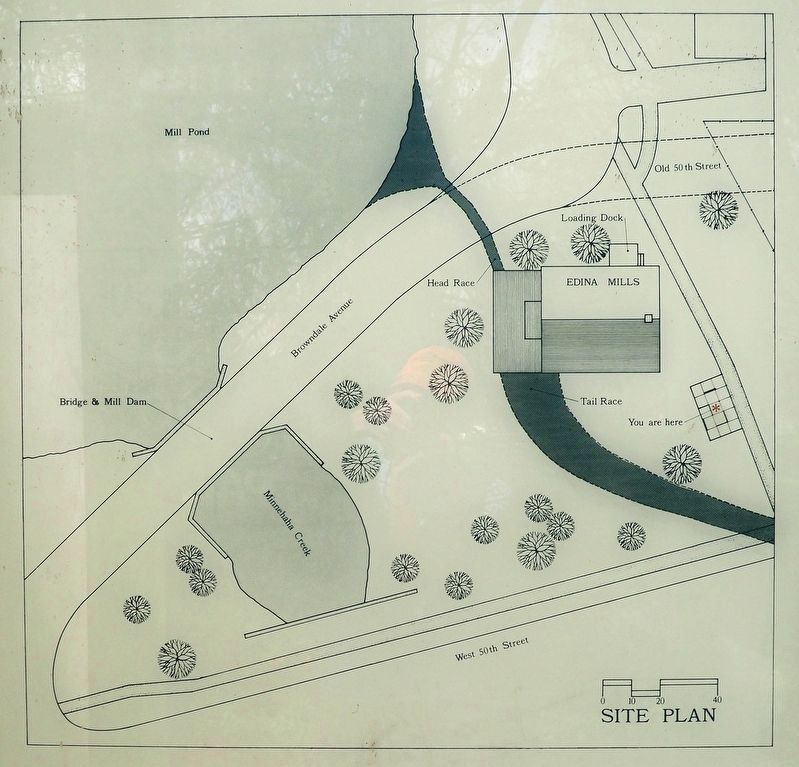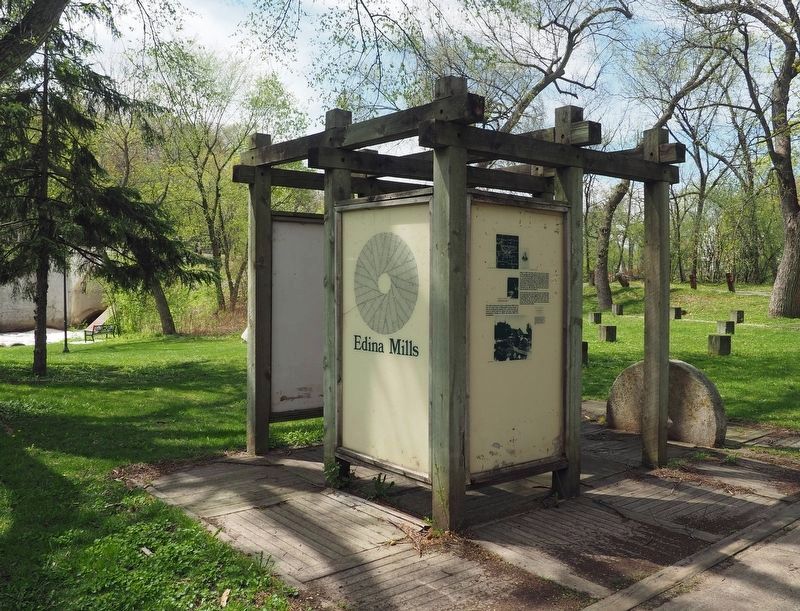Country Club in Edina in Hennepin County, Minnesota — The American Midwest (Upper Plains)
Edina Mills
Built in 1857, the flour mill on this site was central to the growth and development of the City of Edina. The year 1869 brought a Scots miller, Andrew Craik, to a small community then called Waterville Mills. Craik purchased the twelve-year-old business known variously as Waterville Mills, the Red Mill and Buckwalter Mill, and named it Edina Mills after his boyhood home of Edinburgh. This name soon came to represent not only the mill itself but also the growing community surrounding it.
Craik and his sons set about the task of improving and expanding the mill's capabilities. They brought in another Scot, George Millam, who was to be the "Edina Miller" for the next twenty years. The mill was widely known as an outlet for feed, flour and grain, and was the only mill in the state producing oatmeal and pearl barley.
The mill continued to thrive until about 1895, when the low water level of Minnehaha Creek forced an end to commercial milling. For a time the mill was used to grind feed for cattle, but was eventually abandoned. Finally, in 1932, the Edina Mills was demolished.
Captions: Map of Edina Mills, 1890
George Millam, c. 1849-1935
The "Miller of Edina" is shown here inside Edina Mills about 1925
Edina Mills, 1893
Andrew Craik, 1817-1892
Edina Mills business card from the period between 1868 and 1875. The list of products appearing on the reverse side include: Oat Meal, Pearl Barley, Cracked Wheat, Graham Flour, Family Flour, XXXX Flour, Fancy Extra, Bolted Corn Meal, Unbolted Corn Meal, Rye Meal, Rye Flour and Buckwheat Flour.
The Edina Mills was a two-story building, forty feet long and thirty-six feet wide. The mill was of heavy timber construction, covered with vertical twelve inch wide boards. Much of the lumber used in the construction was cut from the woods nearby.
The Edina Mills had three pairs of millstones. Two of these sets were French buhrstones, considered to be the finest type available. They were assembled from pieces of quartz, quarried near Paris. The pieces were carefully fitted together, bound with iron hoops and backed with a coating of plaster of Paris. The third set, or run, of millstones was made in one piece and came from a quarry in Ohio. Cut into the faces of these stones was a pattern of lands and furrows or grooves. As the runner stone on the top rotated just above the stationary bedstone below, the wheat was ground into flour by the scissors action created by the intersecting patterns of lands and grooves. The flour was then cooled, sifted, bagged by automatic action and finally, labeled "Edina Mills Family Flour."
Although originally powered by a wooden overshot waterwheel, the Edina Mills was soon converted to turbine power. In 1879, the millstones and other milling machinery were driven by three turbines generating forty-five horsepower. One of these, a thirty-inch diameter "American" turbine, was recovered from its original location in the wheel pit during exploration of the mill site in 1977. The submerged turbines were superior to the older waterwheels because they required less maintenance and did not freeze in winter.
Captions:
Edina Mills, 1925
This lithograph of an automatic mill from Oliver Evans' A Young Millwrights Guide, c. 1785, was a source used by millwrights to plan and build mills such as the one in Edina.
This exploded drawing of a run of stones shows the runner stone, which rotates, raised clear of the stationary bedstone, which is set into the floor of the mill.
Diagram from Windmills & Watermills, by John Reynolds
The "American" turbine found in the 1977 excavation at the Edina Mills site.
An "American" turbine
Topics. This historical marker is listed in this topic list: Industry & Commerce. A significant historical year for this entry is 1857.
Location. 44° 54.736′ N, 93° 20.513′ W. Marker is in Edina, Minnesota, in Hennepin County. It is in Country Club. Marker can be reached from West 50th Street east of Browndale Avenue, on the left when traveling east. The marker is in Williams Park, along a path on the north side of West 50th Street. There is a parking lot on either side of 50th Street a short distance to the east. Touch for map. Marker is in this post office area: Minneapolis MN 55424, United States of America. Touch for directions.
Other nearby markers. At least 8 other markers are within 2 miles of this marker, measured as the crow flies. Dwight Williams Park (a few steps from this marker); Edina Mill: A Fast Creek Generates Industry... and a Community (a few steps from this marker); A Creek, a Cause and Some Cows: Add Together, What Do You Get? (about 400 feet away, measured in a direct line); Edina Veterans Memorial (about 400 feet away); Minnehaha Grange Hall (approx. 0.4 miles away); Old Cahill School (approx. 0.4 miles away); Como–Harriet Streetcar Line (approx. 1.9 miles away); First School House (approx. 1.9 miles away). Touch for a list and map of all markers in Edina.
Credits. This page was last revised on February 12, 2023. It was originally submitted on May 22, 2022, by McGhiever of Minneapolis, Minnesota. This page has been viewed 551 times since then and 21 times this year. Photos: 1, 2, 3, 4. submitted on May 22, 2022, by McGhiever of Minneapolis, Minnesota. • J. Makali Bruton was the editor who published this page.



